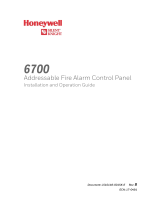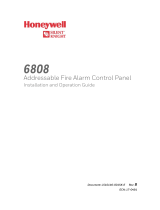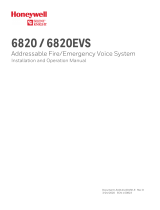Page is loading ...

Installation Manual: PAD200-DUCTR Analog Addressable Duct Detector
NOTICE TO THE INSTALLER
This manual provides an overview and the installation instructions for the PAD200-DUCTR module. This module is only compatible
with addressable re systems that utilize the PAD Addressable Protocol.
All terminals are power limited and should be wired in accordance with the requirements of NFPA 70 (NEC) and NFPA 72 (National
Fire Alarm Code). Failure to follow the wiring diagrams in the following pages will cause the system to not operate as intended. For
further information, refer to the control panel installation instructions.
The module shall only be installed with listed control panels. Refer to the control panel installation manual for proper system
operation.
1. Description
The PAD200-DUCTR duct smoke detector provides early detection of smoke and products of combustion present in the air moving
through HVAC ducts in commercial, industrial and residential applications. The PAD200-DUCTR is designed and built to meet all
local requirements, as well as the NFPA regulations regarding duct smoke detectors.
Air sampling is accomplished by two tubes which protrude into the duct. An exhaust tube of one standard length (7") is supplied
in the installation kit with the smoke duct unit. Once the duct width has been determined, the air intake sampling tubes must be
ordered. Sampling tubes are supplied in three standard lengths: 2.5 ft., 5 ft., and 10 ft. and cut to size to t the duct. Mounting
the duct smoke unit is accomplished by the use of a template and 2 sheet metal screws, which are provided. Mounting can be
achieved without the removal of the clear cover which is secured by 4 capture screws.
2. Setting the Address
All PAD protocol detectors and modules require an address prior to connection to the panel's SLC loop. Each PAD device's
address (i.e., detector and/or module) is set by changing the dip switches located on the device. PAD device addresses are
comprised of a seven (7) position dip switch used to program each device with an address ranging from 1–127.
Figure 1. PAD Device Dip Switch Addresses Table (Addresses 1–127)
Note: Each "gray" box indicates that the dip switch is "On," and each "white" box indicates "O."
Document 5406429-A 02/21
Potter Electric Signal Company, LLC • St. Louis, MO • Phone: (800) 325-3936 • www.pottersignal.com
PAGE 1 OF 5
124816 32 64 124816 32 64 124816 32 64 124816 32 64 1248163264
1275378103
2285479104
3295580105
4305681106
5315782107
6325883108
7335984109
8346085110
9356186111
10 36 62 87 112
11 37 63 88 113
12 38 64 89 114
13 39 65 90 115
14 40 66 91 116
15 41 67 92 117
16 42 68 93 118
17 43 69 94 119
18 44 70 95 120
19 45 71 96 121
20 46 72 97 122
21 47 73 98 123
22 48 74 99 124
23 49 75 100125
24 50 76 101126
25 51 77 102127
26 52 124816 32 64 124816 32 64 1248163264
124816 32 64 124816 32 64
firealarmresources.com

INSTALLATION MANUAL: PAD200-DUCTR ANALOG ADDRESSABLE DUCT DETECTOR
Document 5406429-A 02/21
Potter Electric Signal Company, LLC • St. Louis, MO • Phone: (800) 325-3936 • www.pottersignal.com
PAGE 2 OF 5
The examples shown below illustrate a PAD device's dip switch settings: the 1st example shows a device not addressed where all
dip switch settings are in the default "O" position, the 2nd illustrates an addressed PAD device via the dip switch settings.
Figure 2. Examples of PAD Device Showing Default Dip Switch Setting (Unaddressed) & Addressed PAD Device
Before connecting a device to the SLC loop, take the following precautions to prevent potential damage to the SLC or device.
• Power to the SLC is removed.
• Field wiring on module is correctly installed.
• Field wiring has no open or short circuits.
3. Technical Specications
Duct Detector Model # PAD200-DUCTR
Operating Voltage 24.0V
Current Draw 500μA
Detector Head Model PAD200-DD
Detector Head Type Photoelectric
Sensitivity Test Method Self diagnostic test
Air Velocity 100 to 4000 ft./min.
Ambient Temperature 32̊ to 120̊ F (0̊ to 49̊ C)
Humidity 10% to 85% Relative humidity (non-condensing)
Housing Material Plastic backbox, clear plastic cover
Finish Gray backbox with clear cover
Dimensions 13 1/2" L x 4 1/2" W x 2 1/4" D
Maximum Net Weight 2 lbs.
Relay Contact Rating 8A@30VDC, 10A@120VAC, 10A@250VAC
Sampling Tubes 2.5 ft., 5 ft., or 10 ft.
Sampling Tube Part Numbers 2.5' = 1000274, 5' = 1000275, 10' = 1000276
4. Wiring Diagrams
The wiring diagrams shown below illustrate how to wire PAD100-DRTS, MS-RA and MS-KA/P/R devices.
Figure 3. Example of Wiring a PAD100-DRTS
Off
On
1 2 4 16
8 32 64 All dip switches are
shown in the "O"
position. Off
On
1 2 4 16
832 64 Example shows this PAD device's
address = 42. Dip switches #2, 8 &
32 are in the "On" position.
T
O ADDRESSABLE
PAD200-DUCTR
DUCT DETECTOR
firealarmresources.com

INSTALLATION MANUAL: PAD200-DUCTR ANALOG ADDRESSABLE DUCT DETECTOR
Document 5406429-A 02/21
Potter Electric Signal Company, LLC • St. Louis, MO • Phone: (800) 325-3936 • www.pottersignal.com
PAGE 3 OF 5
Figure 4. Example of Wiring a PAD100-DRTS
Figure 5. Example of Wiring a MS-RA
Figure 6. Example of Wiring a MS-KA/P/R
Notes:
• SLC wiring style supports the Class A, Class X and Class B.
• SLC loop wiring and Aux PWR wiring are power limited and supervised.
• All wiring is between #12 (max.) and #22 (min.).
• Wire Preparation – Strip all wires 1/4 inch from their edges as shown here:
– Stripping too much insulation may cause a ground fault.
– Stripping too little may cause a poor connection and subsequently an open circuit. 1/4 inch
24VDC FROM FACP OR
PREVIOUS MODULE
FORM C RELAY
10A, 250VAC
TO NEXT MODULE
FROM FACP OR
PREVIOUS MODULE
Note: Jumper must be
in “O” position when
using the MS-KA/P/R.
24VDC TO FACP OR
NEXT MODULE
TO MS-RA (RED WIRE)
TO MS-RA (BLACK WIRE)
SUPERVISION OPTION
SHOWN IN “OFF” POSITION
TO 24VDC
POWER
FORM C RELAY
10A, 250VAC
TO NEXT MODULE
FROM FACP OR
PREVIOUS MODULE
PAD100-DRTS
SUPERVISION OPTION
TO PAD100-DRTS
Note: Keep jumper in
“On” position when
using the PAD100-DRTS
for full wiring supervision.
24VDC FROM FACP OR
PREVIOUS MODULE
FORM C RELAY
10A, 250VAC
TO NEXT MODULE
FROM FACP OR
PREVIOUS MODULE
Note: Jumper must be
using the MS-KA/P/R.
24VDC TO FACP OR
NEXT MODULE
RED
RED
BLACK
KEY SWITCH
MS-KA/P/R
ALARM LED
PILOT LED
BLACK
BLACK
BLACK
SUPERVISION OPTION
SHOWN IN “OFF” POSITION
firealarmresources.com

INSTALLATION MANUAL: PAD200-DUCTR ANALOG ADDRESSABLE DUCT DETECTOR
Document 5406429-A 02/21
Potter Electric Signal Company, LLC • St. Louis, MO • Phone: (800) 325-3936 • www.pottersignal.com
PAGE 4 OF 5
5. Mechanical Installation Instructions
LOCATION PREREQUISITES: This guideline contains general information on the PAD200-DUCTR duct smoke detector
installation, but does not preclude the NFPA and/or ICC documents listed. Potter Electric Signal Company assumes no
responsibility for improperly installed duct detectors. To determine the correct installation position for a PAD200-DUCTR duct
smoke detector, the following factors must be considered.
A. A uniform non-turbulent (laminar) airow between 100 ft/min. to 4,000 ft/min. must be present in the HVAC duct. To determine
duct velocities, examine the engineering specications that dene the expected velocities or use an Alnor model 6000AP
velocity meter (or equivalent).
B. To minimize the impact of air turbulence and stratication on performance, a duct smoke detector should be located as far
as possible downstream from any obstruction (i.e. deector plates, elbows, dampers, etc.). In all situations, conrmation of
velocity and pressure dierential within specications is required.
The pressure dierential between the input sampling high pressure) tube and exhaust (low pressure) tube for the PAD200-
DUCTR duct smoke detector should be greater than 0.01 inches of water and less than 1.2 inches of water.
C. Identify a code compliant location (supply or return side, or both) for the installation of the duct unit that will permit easy access
for viewing and serviceability.
D. When installing on the return side, install duct units prior to the air being exhausted from the building or diluted with outside
“fresh” air.
E. When installing duct smoke units downstream of lters, res occurring in the lters will be detected, but if the lters become
blocked, insucient air ow through the duct unit will prevent the correct operation of the duct detector. Duct units installed in
the supply air side may monitor upstream equipment and/or lters.
F. Where possible, install duct detectors upstream of air humidiers and downstream of dehumidiers.
G. To prevent false alarms, the duct detector should not be mounted in areas of extreme high or low temperatures, in areas
where high humidity exists, or in areas where the duct may contain gases or excessive dust.
SAMPLING TUBE ASSEMBLY: The PAD200-DUCTR duct smoke detectors employ a specially notched sampling tube, which may
be ordered separately in one of four (4) standard lengths.
STN-1.0 For duct widths of 6” TO 1.0’
STN-2.5 For duct widths of 1.0’ TO 3.0’
STN-5.0 For duct widths of 3.0’ TO 5.0’
STN-10.0 For duct widths of 5.0’ TO 10.0’
Standard sampling tubes are steel tubes with air intake holes located the entire length of the tube. These tubes must be cut to
length and should span the entire width of the duct. Sampling tubes over 3.0’ must be supported on the opposite side of the duct.
To ensure the correct operation of the sensing tube, the red end cap (red stopper in installation kit) must be inserted in the end
of the air intake sampling tube. For custom duct widths, always use the next longest standard size and cut down to the exact
requirement.
“NO-TOOLS” TUBE INSTALLATION: The PAD200-DUCTR duct smoke detector provides a unique, patented mechanism for
installation and/or removal of the sampling and exhaust tubes from either the front or rear of the detector housing. Once the airow
direction has been determined, insert the inlet and exhaust tubes into the duct smoke detector. If the cover is in place, the tubes
may be inserted into the back of the detector via the key-slots provided. Simply push the tube into place against the spring loaded
retainer, and turn into the correct position, allowing the key to “lock” the tube in the desired orientation. For front side installation,
simply rotate the tube retainer until the tube may be inserted and oriented properly. Once the tube is installed, rotate the retainer
back into place to lock down the tube. Ensure air intake sampling tube is positioned so that the inlet holes are directly facing the
airow.
Figure 7. Example of the PAD200-DUCTR Duct Detector Placement
INLET TUBE
HOLES FACE
AIR FLOW
DUCT WIDTH AIR FLOW DIRECTION
INSERT RED STOPPER
THIS END OF INLET TUBE
EXHAUST TUBE INSTALLED
DOWNSTREAM OF AIRFLOW
DO NOT INSERT RED STOPPER
NOTE: Mountings shown
are typical. Detectors can
be installed side, bottom
or top of duct as long as
proper tube operation and
ow/pressure performance
is maintained
Tube Support Hole only for Ducts Greater than 3 Feet Wid
e
firealarmresources.com

INSTALLATION MANUAL: PAD200-DUCTR ANALOG ADDRESSABLE DUCT DETECTOR
Document 5406429-A 02/21
Potter Electric Signal Company, LLC • St. Louis, MO • Phone: (800) 325-3936 • www.pottersignal.com
PAGE 5 OF 5
It is possible that the internal relay in the PAD200-DUCTR may be shipped in the non-normal / activated state. To
ensure that the internal relay is set to the normal state, connect the module to the SLC loop and reset the control
panel before terminating the wiring to the module's output.
NOTICE
MOUNTING: After securing the sampling and exhaust tubes to the duct smoke unit, (or initially placing the tubes through the 1¼”
holes drilled or punched in the HVAC duct to accept the inlet sampling and exhaust tubes and then attaching them to the duct unit),
hold the duct unit assembly in position and use (2) # 12 X ½” sheet metal screws (packaged in the installation kit) to secure the
duct smoke detector to the HVAC duct.
AIR SAMPLING VERIFICATION: To ensure correct operation of the duct unit use a Magnehelic dierential pressure gauge, Dwyer
2000 or 4000 Series (or equivalent) to determine the dierential pressure between the inlet (high side) and exhaust (low side)
tubes. The dierential pressure between the two tubes should be greater than 0.01 inches of water and less than 1.2 inches of
water.
Note: For proper operation, the velocity adaptor insert must be installed for air velocities of 100 to 4000 feet per minute. This
adaptor comes installed but can be removed in order to service the detector head. The adaptor must be reinstalled after the
detector head service is complete.
6. Operational Testing
When the PAD200-DUCTR is under normal condition in standby mode, the alarm indicator LEDs on the detector head will pulse
approximately once every 4 seconds.
Note: When a panel is congured to not ash LEDs, the LEDs on the detectors will not ash at any time.
7. Functional Testing
Note: Be sure to dis-engage all alarm signal services, releasing devices and extinguishing systems, prior to performing the
following test, except automatic testing by the FACP. Be sure to re-engage these systems when all testing is complete.
8. Walk Test
The FACP must be placed into Walk Test Mode and follow the steps below. Use the appropriate steps outlined below for the
detector that is to be tested.
Notes:
• Failure to alarm during a test indicates a defective detector. Replace detector immediately.
• PAD200-DUCTR – Use ANSI/UL listed aerosol such as Home Safeguard Model 25S and SDi Smoke Centurion as
acceptable to the Authority Having Jurisdiction (AHJ).
• Insert the test gas nozzle into the test port on the unit cover.
9. Maintenance
The detector should be cleaned as needed. Detectors installed in environments more prone to dust may need cleaning based on
build-up of dust. Clean unit by removing cover and using soft cloth, vacuum or dry compressed air. Clean sensing tubes as needed
to allow for the free ow of air through both inlet and exhaust tubes.
Consult your local code and AHJ requirements for required maintenance schedules.
These instructions do not purport to cover all the details or variations in the equipment described, nor provide for
every possible contingency to be met in connection with installation, operation and maintenance.
Specications subject to change without prior notication.
For Technical Assistance contact Potter Electric Signal Company at 866-956-1211.
Actual performance is based on proper application of the product by a qualied professional.
Should further information be desired or should particular problems arise, which are not covered suciently for
the purchaser's purpose, the matter should be referred to a distributor in your region.
firealarmresources.com
/




